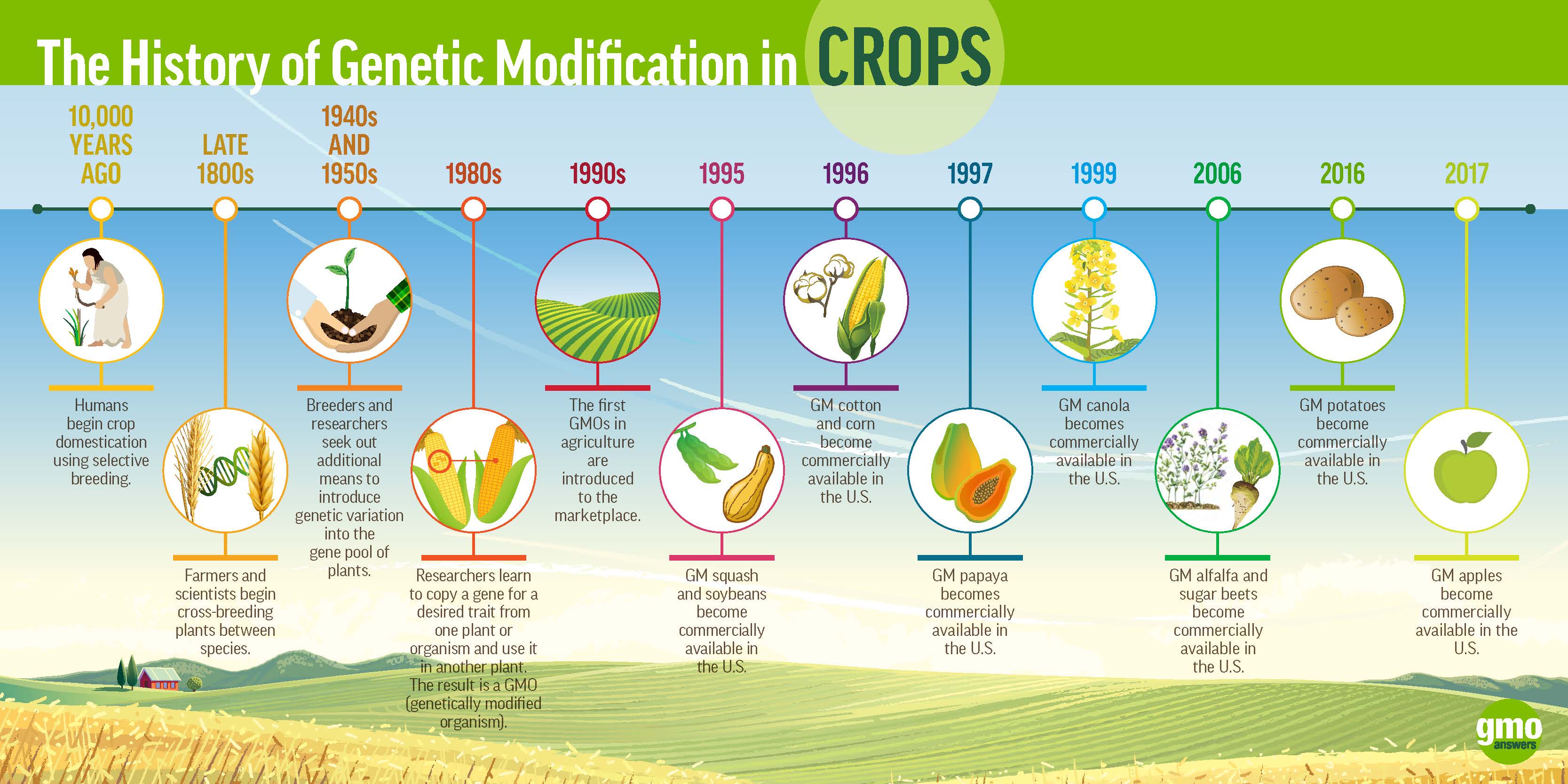The history of agriculture traces back to 10,000 BC when, according to archaeologists, first crops i.e. wheat was cultivated in different areas of the Middle East by humankind. Since antiquity, farmers got aware that some crops can not only produce better yields than others but some of them were naturally more resistant to insects and pests.
Later on, they learned that certain characteristics of crops can be produced by the cross-pollination of parent plants through a method which is called ‘natural selection’ or ‘classical breeding’. However, this method had various disadvantages. A sizeable number of parent plants had to be cross-bred many times to get the desired changes in the genetic makeup of the plants.
Furthermore, it was also observed that the genetic makeup of the offspring would be randomly re-assorted and while some offspring might produce the desired results, other desired genome may be lost along with transfer of undesired genome during the process. Plant breeders thus had to carry out repeated back-crossing to the desirable parent plants which was a time-consuming task.

With the exponential increase in the global population, demand for food and subsequently concerns for food security have also increased dramatically. New methods of crop cultivation have been developed to cater to the increased demands of food. Genetic engineering has provided a novel method for not only increase the production of crops but the quality of crops too.
Genetic engineering uses knowledge of the genetic makeup (DNA and genome) of the organisms and modifies them to produce specific results. Instead of using the more time consuming and more unpredictable natural selection or classical breeding methods, genetic engineering uses methods such as ‘gene technology’ or ‘recombinant gene technology’.
This technology transfers into the selected genes from one organism to another. Thus a herbicide-tolerant plant or a plant resistant to viruses, insects or droughts can be produced. Further variations such as modified flower color composition, delayed ripening or high yield crops can be carried out to create genetically modified (GM) plants.
Transgenic or GM crops have been planted in different countries around the globe from 1996 to 2015. According to a report around 179.7 million hectares planted in 2015 to GM crops with high market value, such as herbicide-tolerant soybean, maize, cotton, and canola; insect resistant maize, cotton, potato, and rice; and virus resistant squash and papaya. More than one trait can be hoarded into a plant with genetic engineering techniques. GM crops with combined traits such as herbicide tolerant and insect resistant maize, soybean and cotton, are also available commercially.
The only GM crop approved and grown in Pakistan is Bt (bacillus thuringiensis) cotton. It is grown mainly in Southern Punjab.
These commercial GM crops have proved instrumental in crop production and a couple of more such products are in the pipeline which will have a profound impact on food quality, environmental factors, pharmaceutical production, and in commercial crops.
For instance, rice has a great number compounds like iron and beta-carotene, which is an important micronutrient convert into vitamin-A in the human body); long-lasting banana ripens faster on the trees and can, therefore, be harvested earlier. Similarly, tomatoes with high levels of flavonols, which are powerful antioxidants; arsenic-tolerant plants; edible vaccines from fruit and vegetables; and low lignin trees for paper making all are examples of such products.

GM crops have not only been used to increase crop productivity but many countries have also used them to solve problems of water salinity and other environmental problems. Creating plants that are resistant and tolerant to drought or salinity (high salt content in soil) can provide solutions to the problems of food security and malnutrition in face of the increased demand for food due to increased global population, especially in developing countries.
The issue of global warming and climate change has emerged as a global challenge in the recent decades affecting the most developed to least developed nations at the same time. Genetically modified trees and plants that specifically target carbon dioxide and help in its sequestration have been demonstrated to be extremely useful in this global fight to reduce carbon dioxide emissions.
However, people in certain countries are concerned about the adverse long term impacts on health and environment which due to GM crops. There is a number of risks associated with the use of biotechnology for crops with negative effects. Allergenicity in the form of serious allergic reactions is a major issue faced by consumers in the USA and Europe. Furthermore, various studies have shown that genetically modified organisms (GMO) can cause unintended harm to other organisms.
For instance, pollen from Bt corn―a GM crop― caused heavy toll of death in monarch butterfly caterpillar. Another unfavorable issue is that there could be cross-breeding between GM herbicide-resistant crops and weeds. This also results in the transfer of herbicide resistance genes to the weeds which will subsequently also become herbicide tolerant. In addition, GM crops affect entire ecosystems and the situation will eventually boil down into biodiversity reduction.
Owing to these concerns many countries have passed legislation acts to protect their consumers and industries form disastrous effects. Furthermore, some international multilateral conventions have signed and ratified by many nations to oversee the moral, ethical and environmental impacts of these genetically modified crops in particular and genetically modified organisms in general.

This includes the Convention on Biological Diversity (1992), the International Plant Protection Convention (IPPC) and Cartagena Protocol. The goal of such efforts is to ensure safe handling, transport, and use of living modified organisms (LMOs), the aftermath of modern biotechnology that may have dire effects on biological diversity, taking into account high risks to human health. The protocol set the advanced agreement procedure for protection and to ensure a safe transfer of living modified organisms, including GM crops, across various countries.

Muhammad Abdullah Khan has done bachelors in Chemistry from Government College University
Lahore. He is a science enthusiast and loves to read and write about astronomy, cosmology and latest
scientific endeavors.

